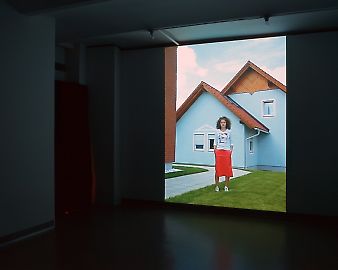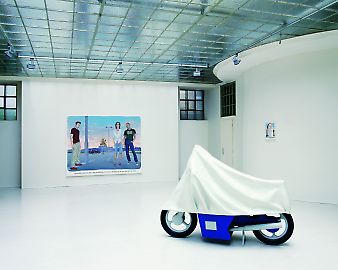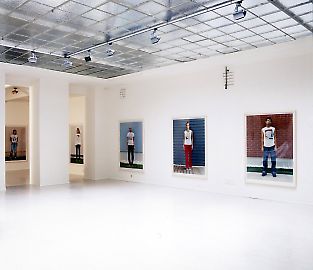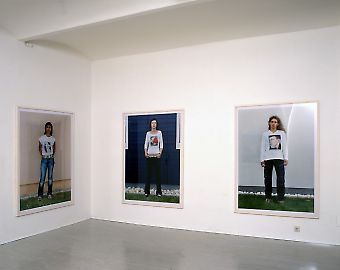Muntean / Rosenblum -- Lost in the savage wilderness of civil life
M.M.: […] We try to come up with a complex structure, in a way a polyphonic structure, like a polyphonic piece of music where each voice has its own input to make and has a certain limit to independence. This complex structure is part of our aim to create a system, which sounds a bit contradictory upon first hearing it, a system of precise ambiguity. This means that each element is self-referential and self-critical in a way. Because each element creates a tension with the other and puts the other one in brackets, it’s still there and you can read it, like a Derrida-ish procedure of crossing-out a word in a sentence to negate the word, and to keep it visible at the same time.
C.W.E.: Tell me about the relationship between the image and the texts. What I really mean by the text are the words written in black below the painting. […] Even, as they might be disjunctive, as a kind of thought bubble which arrives from nowhere. It’s as if the image were plucked from a narrative progression of something and the rest of the story is like the gap between the image and the text. Because, I am not sure if we are reading the subtitle, then projecting a consciousness back onto the subject, or if the character in the picture then has some kind of voice. To what extent is it a voice or a commentary? Possibly I imagine that it’s all of these things.
M.M.: One of the main issues is the contemporary notion of the subject and the question of identity. Is there still a coherent structure to the self? It’s true that the text is a layer of it’s own, so in a way it’s an induced misunderstanding. Because, we are so used to reading a caption beneath a picture you think that it must be explanatory. Then you read the text and there might be some kind of reference to the painted figures in the picture, but in a way there’s not and you don’t know who is speaking, whether it is an individual voice. So, this mirrors exactly what is going on in the painting. You are not sure if it is a real portrait. There might be some sadness in the facial expression, […] and you are not sure if the sadness is vaguely saying the same thing as the text […]. The text is always creating a certain atmosphere, pathos and certain general maxims of life or aphoristic statements in a general way.[…]
C.W.E.: Now, I want to pull it back down to something more pragmatic regarding the relationship to the three-dimensional objects (or sculptures) and the rest of your work. And the other thing I want to talk about is the moving image and the audio or sound element. Because, what we have is the most exciting level of what you are doing at the moment: an extraordinary kind of friction that exists between the contemporary space of the image and the non-contemporary zone of the association with the soundtrack. What’s involved in the extraordinary rupture? Because we are listening to the phenomenological present and the sound being played over that so that we have a ghostly recollection of another time and space, which evoked as a lament, a ‘memento mori.’
A.R.: In the video we are obviously dealing with photography and with real persons showing up, so there it is a different approach here than in the paintings. In the paintings, we try to find the most precise context for the use of a specific way of painting. The traditional figurative painting style functions, in a way, to create a certain aura and emotional impact. This painterly approach has to be well balanced and is quite difficult to achieve, if it takes too long to paint something then we re-paint it because it doesn’t have to be painting for painting’s sake. At the same time, it must be clear that the brushstrokes are important, but one doesn’t have to overdo it […]. In the video, this emotional impact and aura is provided by the soundtrack. […]
M.M.: […] there is some passion about the musical selection and it is definitely going towards early music and polyphonic music. Renaissance and Baroque music is often regarded as merely artificial and highly mathematical and abstract, without any emotional impact. So, we are back again at the wrong dichotomy between the natural and the artificial. The ideal of the natural in this case would be a complete homophonic music, of only one voice without accompaniment. It is interesting to mention in this context that the music of Rameau was heavily attacked by Rousseau for being too artificial and complicated and being against nature in a way. […]
C.W.E.: I think what you make is highly conceptual as a practice, because it’s extremely involved with strategies which test the viewers’ correspondence and their inter-subjectivity to the work. I want to narrow it down a little bit more and talk about the relationship between the sculptural works. If we can make this cruder distinction between 3-dimensional objects as a kind of simulacrum of something which could exist in the world […] and those which are distorted beyond every practicality, to what extent does the lack of functionality make the object more real?
A.R.: I think it’s more of a metaphor for something. We did have this debate about whether it should work and we realized it was wrong. Because, it should be both a sculpture as well as a metaphor for something. […]
M.M.: Again, the ‘memento mori’ is a key thing. It’s a really serious issue. It’s a vehicle, it’s this machine or object from a gym and so you recognize it. But, it is not realistic, […].The aim is giving as much information as you need to recognize the object and to make clear the reference to the real object, but to make it completely like a sculpture. The style of the sculpture is almost funny or naïve […].
C.W.E.: […] There is a sophistication, which is focused on the naïveté of the whole thing. Otherwise you would be hyper-realist sculptors, or you would be ready-made artists using BMX bikes or something of the sort. For me, there is a degree of cruelty that is introduced in the sculptural aspect and a degree of frustration in engaging with this thing that cannot and will not work. […] Actually, I think the objects are punishing, they have a powerful, I would even say, aggressive effect. They somehow balance the melancholic drift of the subject’s space.
(Revised version) Cerith Wyn Evans, “Cerith Wyn Evans in Conversation with Markus Muntean and Adi Rosenblum,” in: exhibition catalogue To Die For–Muntean/Rosenblum, De Appel Foundation, Amsterdam, 2002, pp. 52-60.






